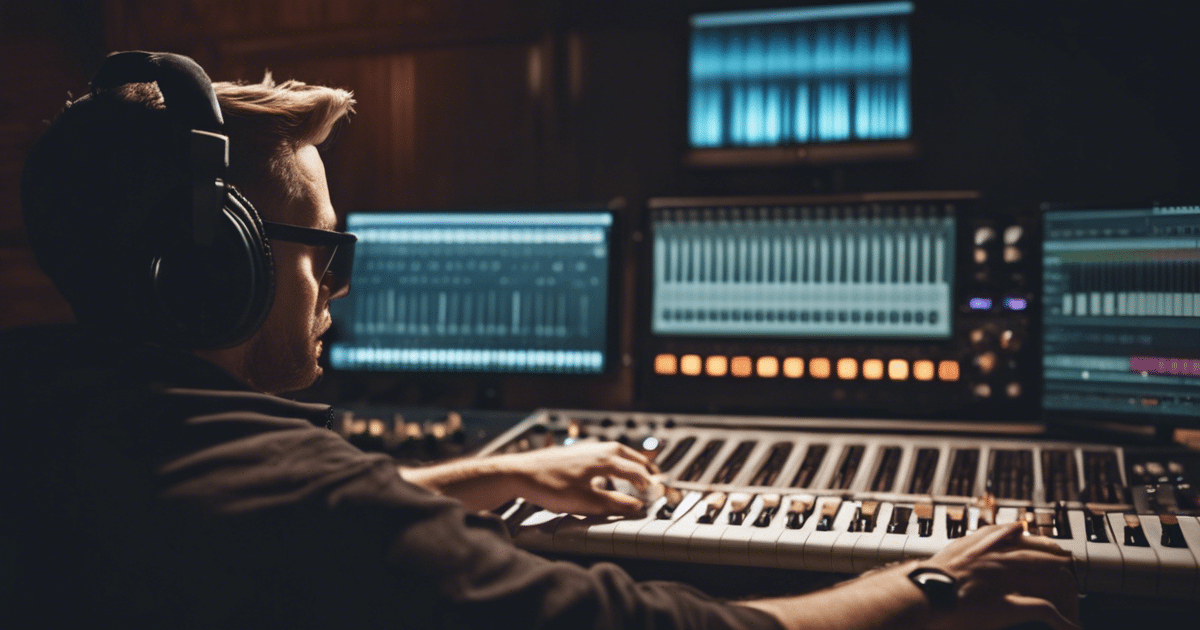Estimated reading time: 9 minutes
Introduction: Embarking on Your Musical Journey
Creating a music album is a thrilling and rewarding experience for musicians, singers, and producers alike. It’s an opportunity to showcase your artistic vision, share your musical talents with the world, and potentially launch or advance your music career. Whether you’re a seasoned professional or a newcomer artist, the process of making an album involves numerous steps, creative decisions, and technical considerations.
In this comprehensive guide, we’ll walk you through the entire process of how to make a music album, from the initial concept to the final release. We’ll cover everything from pre-production and songwriting to recording, mixing, and promotion. So, grab your instrument, fire up your creativity, and let’s dive into the exciting world of album creation!
Table of contents
- Introduction: Embarking on Your Musical Journey
- Conceptualizing Your Album: Laying the Foundation
- Pre-Production: Setting the Stage for Success
- The Recording Process: Bringing Your Music to Life
- Post-Production: Polishing Your Sound
- Visual Elements: Creating a Complete Package
- Preparing for Release: Getting Your Music Out There
- Promotion: Sharing Your Music with the World
- Post-Release: Keeping the Momentum Going
- Video: How to Create an Album! (In 6 Simple Steps)
- Conclusion: Celebrating Your Musical Achievement
- FAQs
Conceptualizing Your Album: Laying the Foundation
Defining Your Musical Vision
Before you start recording, it’s crucial to have a clear idea of what you want your album to be. Ask yourself:
- What genre or style of music will you focus on?
- What themes or emotions do you want to convey?
- Are you aiming for a concept album with a cohesive theme, or a collection of individual songs?
Take some time to reflect on these questions and jot down your ideas. This will help guide your creative process and ensure your album has a unified direction.
Choosing an Album Title and Theme
Your album title and overall theme play a significant role in how listeners perceive your work. Consider the following:
- Brainstorm potential album titles that reflect your musical vision
- Think about lyrical themes that tie your songs together
- Consider how the album title and theme relate to your artistic identity
Remember, the album title and theme should resonate with your target audience and give them a sense of what to expect from your music.
Pre-Production: Setting the Stage for Success
Songwriting and Selection
The heart of any great album is its songs. During the pre-production phase:
- Write new material or revisit existing songs
- Aim for a collection of 8-15 songs for a full-length album
- Ensure each track contributes to the overall album concept
- Avoid “album fillers” – every song should earn its place
Take your time with this process. Quality songwriting is the foundation of a successful album.
Creating Demo Recordings
Before heading into the studio, it’s helpful to create demo recordings of your songs. This allows you to:
- Experiment with different arrangements
- Get feedback from bandmates, friends, or mentors
- Identify areas for improvement before the final recording
Demo recordings don’t need to be perfect – they’re a tool to help you refine your songs and prepare for the studio.
Planning Your Recording Setup
Decide where and how you’ll record your album. Your options include:
- Professional recording studio
- Home studio setup
- Hybrid approach (recording some elements at home, others in a pro studio)
Consider your budget, technical skills, and the sound you’re aiming for when making this decision.
The Recording Process: Bringing Your Music to Life
Setting Up Your Recording Space
Whether you’re in a professional studio or recording at home, proper setup is crucial:
- Ensure good acoustics in your recording space
- Set up microphones and instruments correctly
- Test your recording equipment before starting
A well-prepared recording space will save you time and help you achieve better sound quality.

Recording Tracks
Now it’s time to lay down your tracks. Here’s a typical order of recording:
- Rhythm section (drums, bass)
- Harmony instruments (guitar, keyboards)
- Lead instruments
- Vocals (see here the best DAWs to record vocals)
- Background vocals and additional elements
Remember to take breaks and stay hydrated during long recording sessions. Fresh ears and a clear mind will help you perform at your best.
Capturing the Perfect Take
Don’t be afraid to do multiple takes of each part. Aim for performances that:
- Are in tune and in time
- Capture the emotion of the song
- Fit well with the other recorded elements
Sometimes, the “perfect” take isn’t technically flawless but captures the right feeling or energy.
Post-Production: Polishing Your Sound
Mixing
Mixing is where your recorded tracks come together to form a cohesive sound. During this stage:
- Balance the volume levels of different tracks
- Apply effects like reverb, delay, or compression
- Create a stereo image that enhances the listening experience
Consider working with a professional mixing engineer if you’re not confident in your mixing skills.
Mastering
Mastering is the final step in audio post-production. It involves:
- Ensuring consistent volume and tone across all tracks
- Optimizing the album for various playback systems
- Preparing the audio for different formats (streaming, CD, vinyl)
Professional mastering can give your album that polished, radio-ready sound.
Visual Elements: Creating a Complete Package
Designing Album Artwork
Your album cover art is often the first thing potential listeners see. When designing your cover:
- Choose imagery that reflects your music and album theme
- Consider hiring a graphic designer or visual artist
- Ensure the design looks good in various sizes (from vinyl covers to tiny streaming thumbnails)
Remember, great album artwork can be as iconic as the music itself.

Creating Additional Visual Content
In today’s digital age, visual content is crucial for promotion. Consider creating:
- Music videos for key tracks
- Behind-the-scenes footage of the recording process
- Lyric videos or visualizers
These elements can help engage fans and promote your album across various platforms.
Preparing for Release: Getting Your Music Out There
Choosing a Release Strategy
Decide how you want to release your album:
- Traditional physical release (CDs, vinyl records)
- Digital release on streaming platforms
- Combination of physical and digital
Each approach has its pros and cons, so choose the one that best fits your goals and audience.
Selecting a Digital Distributor
If you’re releasing your album on streaming platforms like Apple Music or Spotify, you’ll need a digital distributor. Research different options and consider factors like:
- Distribution fees
- Royalty rates
- Additional services offered (e.g., playlist pitching, marketing tools)
Planning Your Album Release Party
An album release party can be a great way to celebrate your hard work and generate buzz. Consider:
- Venue selection
- Guest list (fans, industry professionals, media)
- Live performance of album tracks
- Merchandise sales
Make it a memorable event that reflects your music and personality.
Promotion: Sharing Your Music with the World
Building Anticipation
Start promoting your album well before the release date:
- Tease snippets of songs on social media
- Share behind-the-scenes content from the recording process
- Release a single or two to generate interest
Engagement with your fans during this period can help create excitement for the full album release.
Leveraging Social Media
Use social media platforms to connect with your audience:
- Share regular updates about your album
- Interact with fans through Q&A sessions or live streams
- Create shareable content related to your album
Consistency and authenticity are key to building a strong social media presence.
Reaching Out to Media and Influencers
Get your music in front of a wider audience by:
- Submitting your album to music blogs and online publications for review
- Reaching out to playlist curators on streaming platforms
- Connecting with social media influencers in the music space
Personal, tailored outreach often yields better results than mass emails.
Post-Release: Keeping the Momentum Going
Monitoring Performance
Once your album is out, keep track of its performance:
- Use analytics tools provided by streaming platforms
- Monitor social media engagement and follower growth
- Track physical and digital sales
This data can help inform your future marketing efforts and music career decisions.
Planning Live Performances
Live shows are a great way to promote your album and connect with fans:
- Organize an album tour if possible
- Perform at local venues and events
- Consider live streaming performances for fans who can’t attend in person
Live performances can help bring your album to life and create lasting memories for your audience.
Gathering Feedback
Listen to what your fans and critics are saying about your album:
- Read and respond to comments on social media and streaming platforms
- Pay attention to professional reviews
- Use this feedback to inform your future music projects
Constructive criticism can be a valuable tool for growth as an artist.
Video: How to Create an Album! (In 6 Simple Steps)
Conclusion: Celebrating Your Musical Achievement
Creating a music album is a journey filled with challenges, learning experiences, and moments of pure joy. From the initial spark of inspiration to the final release and beyond, each step of the process contributes to your growth as an artist.
Remember, there’s no one-size-fits-all approach to making an album. Use this guide as a roadmap, but don’t be afraid to forge your own path and let your unique artistic vision shine through. Whether your album becomes a chart-topping hit or a beloved indie gem, the act of creating and sharing your music is a significant accomplishment.
As you embark on your album-making journey, stay true to your artistic vision, be open to learning and collaboration, and most importantly, enjoy the process. Your passion and dedication will resonate through your music, connecting with listeners and potentially launching the next chapter of your music career.
So, pick up that instrument, fire up that recording software, and start creating. Your musical story is waiting to be told, and your album could be the soundtrack to someone’s life. Happy recording!
Related Posts
FAQs
The first step is conceptualizing your album. This involves defining your musical vision, deciding on a genre, and thinking about the themes or emotions you want to convey. It’s also important to choose an album title and theme that resonates with your target audience.
A full-length album typically contains 8-15 songs. Focus on quality over quantity—each track should contribute to the overall album concept, avoiding “album fillers” that don’t add value to the project.
You can record in a professional studio, at home, or take a hybrid approach. The decision depends on your budget, technical skills, and the sound you want to achieve. Professional studios offer high-quality equipment, but home studios can offer more flexibility and cost savings.
Mixing involves balancing the volume of tracks, applying effects, and creating a cohesive sound. Mastering is the final step, ensuring consistent volume and tone across all tracks while optimizing them for various formats like streaming, CDs, or vinyl.
Start by building anticipation on social media, sharing teasers, and releasing singles. Reach out to music blogs, playlist curators, and influencers for reviews and promotion. Hosting a release party or live performance can also generate excitement and help you connect with fans.
